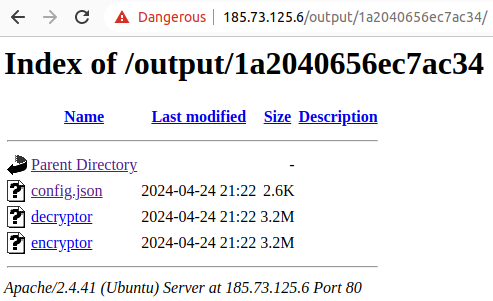Mallox ransomware, which is also known as Fargo, TargetCompany, Mawahelper, and so on, has been active since mid-2021. Their operation was also observed in transitioning into the Ransomware-as-a-Service distribution model from mid-2022. Mallox group focuses on multi-extortion, encrypting their victims’ data and threatening to post it on their public TOR-based sites. At initial versions, Mallox payloads are usually .NET-based, .EXE, or .DLL files which were spread through various methods, including exposed MS-SQL servers and phishing or spam emails to target Windows systems. Now, the new Mallox ransomware Linux variants have been found in the wild. The attackers are using custom python scripts for the purpose of payload delivery and victim's information exfiltration. The malware encrypts user data and appends .locked extension to the encrypted files. The Uptycs Threat Research team discovered a Python script named web_server.py during their investigation. Upon examining its contents and functions, it was identified as The Flask based Mallox ransomware web panel that can be used to create a fast and customizable ransomware for linux systems. The script connects to a backend database using environment variables for database credentials. It includes routes for user authentication, build management, and admin functions, supporting new user registration, login, password reset, and ransomware build creation, management, and downloading. Admins can manage users, view logs, and perform account actions. Additionally, the application features user profile management, a chat interface for builds, and a custom 404 error page. The script (web_server.py) essentially creates a Mallox ransomware encryptor along with a decryptor for any user who registers. It contains an IP address: 185[.]73[.]125[.]6 in the host IP field. This ip is mainly used by someone to build newly linux ransomware builder for Mallox based on used config file, latter can be used for encrypt the system Following that 185[.]73[.]125[.]6/output reveals the following contents: The above screenshot displays build IDs, and opening any of the links reveals the encryptor, decryptor, and config.json files. Let's discuss the Ransomware Encryptor. Upon examining the strings of the sample, we notice a base64-encoded content that appears not to be standard base64. The above base64 content is converted to hex and then xor with 0x9b (155 decimal) and then AES-256-CBC decryption with "iv": "/4EvHTiTUuIMrzjYSpnVLQ==", "key": "Byw184x2xrm0qF7sR7fptq1F/96GeD2TAYwbZDSX9dM=" After decrypting all the base-64 encoded content using the above logic, we obtained the ransomware configuration We can see the entire configuration below which includes ransom-note,Client ID,BTC Address,Amount (USD),Deadline, Tox chat ID,note_name,persist,target-id and targeted directories. From the above configuration, it is evident that the payload is Mallox Ransomware. The ransomware uses the same AES-256 CBC encryption to encrypt files on the victim's machine (similar to decrypting the config), with 'iv': '/4EvHTiTUuIMrzjYSpnVLQ==' and 'key': 'Byw184x2xrm0qF7sR7fptq1F/96GeD2TAYwbZDSX9dM='. AES is a symmetric algorithm and for any encrypted file it can be decrypted with the same key and IV. After encryption the Ransomware appends extension .lmallox and drops a Ransomnote with name READ_THIS_NOW.txt Decryptor file is available on 185[.]73[.]125[.]6/output/{build-id}/decryptor for the corresponding encryptor. Uptycs Threat Research team has collected 7 decryptors for their corresponding encryptors for the following build-ids (chat-id): Uptycs demonstrates robust detection capabilities, featuring built-in YARA support and advanced functionality for identifying such campaign activity threats with the detailed descriptions. The Following Figure shows the Uptycs detection Following graph show the how can we hunt for current mallox hosted server by performing following query on FOFA or Censys Indicator Type Indicators File name IP 185[.]73[.]125[.]6 IP 91[.]215[.]85[.]142 IP 91[.]215[.]85[.]135 MD5 3dde1507996cf8c3dd53a726501be33b Webserver.py MD5 b0770b7f24a436d256f2d58fc8581a18 decryptor MD5 231478ff24055d5cdb5fbec36060c8ff encryptor MD5 51d51696c7f3a0e3fba4b8ceab210bac decryptor MD5 8d0fd41d35df82d3e7e2ff5c1747b87c encryptor MD5 e9e087c52b97c7a3e343642379829e0a decryptor MD5 68785d476573955d50a3908dc18bf73b encryptor MD5 cb60ad37c9a632c697fb2da7add7ccb5 decryptor MD5 6bb2752ea73b4d6a5c33f543b5c29461 encryptor MD5 1448ce8abc2f0184ec898d55f9c338b4 decryptor MD5 5b0c1958a875c205951b88fd1c885900 encryptor MD5 7f099845d8e6849d6ab4d64b546477d6 decryptor MD5 4825f3a92780be4a285583b0f24fed99 encryptor MD5 be08c3e95df5992903a69e04cbab22e3 decryptor MD5 779aa15cd6a8d416e7f722331d87f47b encryptorOverview
 Figure 1: Mallox ransomware diamond model
Figure 1: Mallox ransomware diamond modelTechnical Analysis
 Figure 2: Web_Server.py script contents
Figure 2: Web_Server.py script contents Figure 3: Index of /output
Figure 3: Index of /output Figure 4: Index of /output/{build-id}
Figure 4: Index of /output/{build-id}Encryptor
 Figure 5: Encrypted config
Figure 5: Encrypted config Figure 6: Decryption logic
Figure 6: Decryption logic Figure 7: Decrypted config
Figure 7: Decrypted config Figure 8: Ransomware Configuration
Figure 8: Ransomware Configuration Figure 9: Ransom-note
Figure 9: Ransom-noteDecryptor
Uptycs XDR Coverage
 Figure 10: Uptycs detection
Figure 10: Uptycs detectionHunting for Mallox Infrastructure
 Figure 11: Hunting Mallox ransomware Infrastructure
Figure 11: Hunting Mallox ransomware InfrastructureIndicators of Compromise
Yara detection:


Mallox Ransomware: Linux Variant Decryptor Found | Uptycs
2024-7-4 04:32:59 Author: www.uptycs.com(查看原文) 阅读量:72 收藏
2024-7-4 04:32:59 Author: www.uptycs.com(查看原文) 阅读量:72 收藏
文章来源: https://www.uptycs.com/blog/mallox-ransomware-linux-variant-decryptor-discovered
如有侵权请联系:admin#unsafe.sh
如有侵权请联系:admin#unsafe.sh